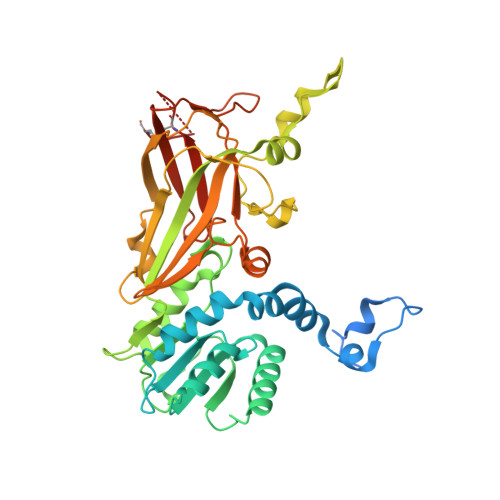A glutamate/aspartate switch controls product specificity in a protein arginine methyltransferase.
Debler, E.W., Jain, K., Warmack, R.A., Feng, Y., Clarke, S.G., Blobel, G., Stavropoulos, P.(2016) Proc Natl Acad Sci U S A 113: 2068-2073
- PubMed: 26858449
- DOI: https://doi.org/10.1073/pnas.1525783113
- Primary Citation of Related Structures:
5EKU - PubMed Abstract:
Trypanosoma brucei PRMT7 (TbPRMT7) is a protein arginine methyltransferase (PRMT) that strictly monomethylates various substrates, thus classifying it as a type III PRMT. However, the molecular basis of its unique product specificity has remained elusive. Here, we present the structure of TbPRMT7 in complex with its cofactor product S-adenosyl-l-homocysteine (AdoHcy) at 2.8 Å resolution and identify a glutamate residue critical for its monomethylation behavior. TbPRMT7 comprises the conserved methyltransferase and β-barrel domains, an N-terminal extension, and a dimerization arm. The active site at the interface of the N-terminal extension, methyltransferase, and β-barrel domains is stabilized by the dimerization arm of the neighboring protomer, providing a structural basis for dimerization as a prerequisite for catalytic activity. Mutagenesis of active-site residues highlights the importance of Glu181, the second of the two invariant glutamate residues of the double E loop that coordinate the target arginine in substrate peptides/proteins and that increase its nucleophilicity. Strikingly, mutation of Glu181 to aspartate converts TbPRMT7 into a type I PRMT, producing asymmetric dimethylarginine (ADMA). Isothermal titration calorimetry (ITC) using a histone H4 peptide showed that the Glu181Asp mutant has markedly increased affinity for monomethylated peptide with respect to the WT, suggesting that the enlarged active site can favorably accommodate monomethylated peptide and provide sufficient space for ADMA formation. In conclusion, these findings yield valuable insights into the product specificity and the catalytic mechanism of protein arginine methyltransferases and have important implications for the rational (re)design of PRMTs.
Organizational Affiliation:
Laboratory of Cell Biology, The Rockefeller University, New York, NY 10065; Howard Hughes Medical Institute, The Rockefeller University, New York, NY 10065; edebler@rockefeller.edu blobel@rockefeller.edu stavrop@rockefeller.edu.















